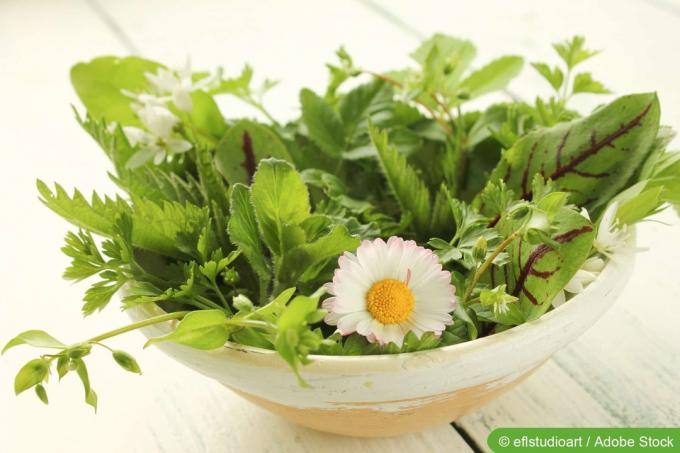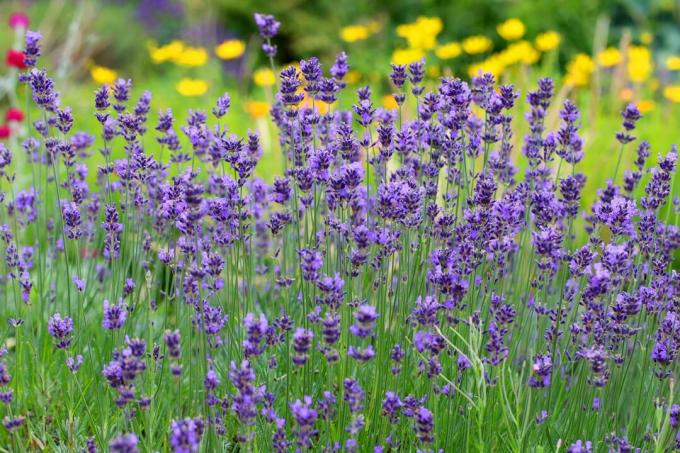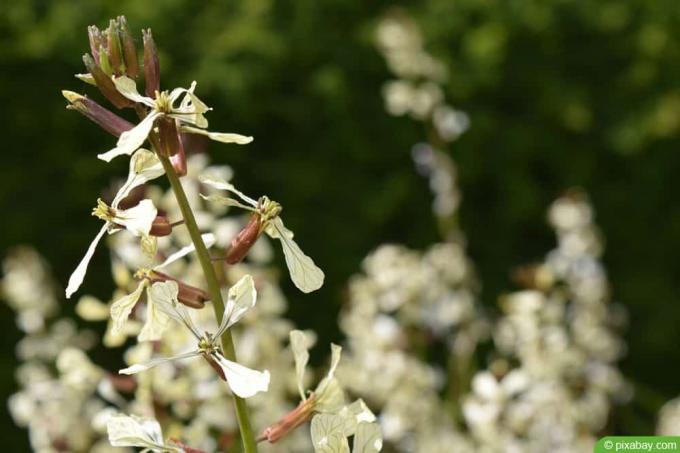

Table of contents
- Tips about wild herbs
- harvest
- recognize plants
- gathering places
- collection time
- preservation
- frequently asked Questions
- Worth knowing about wild herbs in brief
- Common wild herbs to get to know
- Collect wild herbs
- Wild herbs for the menu
Many people would refer to wild herbs as weeds. They are full of vitamins, secondary plant substances, trace elements and are extremely tasty. The delicacies are real sources of energy and some wild herbs have even proven themselves as medicinal plants.
The edible plants from the wild enrich many dishes in the kitchen and are often used in salads. They thrive on fields, meadows, river meadows, forests or on the edge of paths. Collected, harvested and preserved at the right time, they can be enjoyed all year round.
Tips about wild herbs
Wild herbs are culinary delicacies, but not every wild plant is edible. Among them are numerous poisonous plants. Anyone who collects their herbs in nature should only ever harvest as much as can be processed. Herbs that are not used can be preserved. Wild herbs can be preserved in vinegar and oil, frozen, dried or otherwise preserved.
harvest
Before the wild herbs can be preserved, they must first be collected. It is not advisable to dig up the entire plant with its roots and never collect all the flowers and leaves. This is the only way the plant can continue to grow. Harvesting rare plants is taboo! The wild treasures are worthless if they turn black after drying. They are best transported in an airy basket. They can rot in plastic bags.
recognize plants
- Wild herbs must be clearly identified.
- Species such as dandelion, nettle or daisy can be assigned quite easily.
- Some plants can sometimes be confused.
- Representatives of the umbelliferae family are difficult to distinguish.
- Be sure to refrain from unfamiliar herbs.
gathering places
- Meadows, river meadows, fields, forests, roadsides are ideal.
- Plants on roadsides should not be harvested due to pollution.
- Agricultural areas are to be avoided because of the crop sprays.
- In addition, private property and dog walks are not suitable places for collecting wild herbs.
collection time
- As a rule, most wild herbs are collected from spring to autumn.
- Cabbage and leaves are collected either before or after the flowering phase in the morning.
- Harvest buds just before they open and flowers after they open
- Harvesting the fruits and berries of wild herbs only happens when they are fully ripe.
- In spring and autumn, the roots can be dug up in the evening hours.
preservation
- most herbs can be dried
- tie small bouquets and hang them upside down
- dry naturally in summer
- Dry overnight in the oven at 30 degrees Celsius in winter
- so the aroma is preserved.
- For pickling, the wild herbs are placed in a lockable container that is filled with oil or vinegar
- If the herbs are to be frozen, they must first be washed well, dabbed and chopped finely
- freeze small whole bouquets
Tip:
Homemade herb cubes are particularly practical. Fill the ice cube tray two-thirds full with chopped herbs and then fill up with water.
Dandelion (Taraxacum officinale)
Dandelions can be found on railway embankments, unfertilized meadows, roadsides or in cracks in walls. The best harvest time is between May and September. The aroma becomes more and more bitter towards the end of the collection time. For harvesting, the leaf rosettes are cut out and processed fresh. Dandelion is dried in an airy and shady place. In autumn, the roots are particularly easy to collect. Then remove the side roots, wash, cut into pieces and dry in the oven or in the sun.
Daisy (Bellis perennis)
The daisy - often referred to as daisies or daisies - can often be found in pastures and meadows, in forest clearings or along roadsides. The best harvest time is between April and November. Daisies can also be dried or used fresh. However, they prefer a shady and cool place to dry. Leaves and flowers of the wild plant must be protected from moisture and light. Buds pickled in vinegar taste like capers.
wild garlic (Allium ursinum)
- is considered a delicacy among wild herbs
- Location is humid deciduous forests
- Flowering time between April and June
- only process fresh
- do not dry, otherwise ingredients will be lost
- however, shredded leaves can be frozen
- Caution! Risk of confusion with lily of the valley
- Plants can be distinguished by the typical smell of garlic
Stinging nettle (Urtica dioica)
The taste of the young nettle leaves and shoots is reminiscent of spinach. The "burning" little plant prefers locations with humus-rich and nitrogen-rich soil. It grows between heaps of rubble and scree, on fences, roads and paths, and on fallow land. The nettle plant can be harvested between April and October. The young leaves and fresh leaf tips are plucked off during flowering and dried and stored in a dry, cool place.
Woodruff (Galium odoratum)
The shapely woodruff is particularly at home in shady spots, forest clearings and deciduous forests. It is collected between May and July. If possible, only collect young and flowering plants. To dry, woodruff is stored in loose layers protected from light.
Plantain (Plantago lanceolata)
- Plantain plants can be found literally on every road and forest edge, on country lanes and as "weeds" in the home garden.
- young, long, narrow leaves and inflorescences can be harvested from April to August.
- Cut into strips to dry and layer loosely
- Thread the leaves onto a string and let them wilt
- store in the paper bag
Sorrel (Rumex acetosa)
The knotweed thrives along roadsides and in meadows. The flowering period is limited to the period from May to August. The leaves of the sorrel may only be harvested if they are unblemished. Leaves with rust-brown holes have a high concentration of oxalic acid, which is not well tolerated by people with stomach and kidney problems.
Ground ivy (Glechoma hederacea)
Sometimes the Gundermann can already be harvested in March. His season ends in October. The mint family can be found on fields, meadows, in the forest or along roadsides. Leaves, stems and flowers can be harvested from the plant. It is dried in shady places in thin layers.
Chickweed (Stellaria media)
Chickweed can be found literally anywhere there is moist soil. The above-ground parts of the plant can be harvested until October and dried in semi-shade. The carnation plant is kept in a box.
Tip:
The plant grows even in winter. If you don't want to do without fresh chickweed even in the cold season, just look under the snow.
frequently asked Questions
In general, collecting wild herbs only makes sense in dry weather. In addition, the plants must be free from moisture. If they are harvested wet, they start to rot easily.
In the first three months of pregnancy, herbal stimulants and medicinal products should be avoided. This also applies to wild herbs, since the plants sometimes contain a high concentration of secondary plant substances.
Worth knowing about wild herbs in brief
- Herbs not only refine dishes and give them a special aroma, they are also rich in vitamins and minerals and therefore indispensable in the kitchen.
- On grasslands, along the way and in gardens there are numerous wild herbs that have been collected for cooking and medicinal purposes since time immemorial.
- The best-known wild herbs include wild garlic, nettle, mugwort, goutweed, coltsfoot, evening primrose species, avens, red clover, sorrel, yarrow and plantain species.
- Likewise, daisies, dandelions, daisies and violets can also be processed in the kitchen.
- Wild-growing herbs are not only used as a seasoning, they can also be used, depending on the type of herb Vegetables, tea or salad can be prepared.
Common wild herbs to get to know
- stream exercise
- wild garlic
- Comfrey
- birch
- french herb
- Groundman
- nettle
- watercress
- daisy
- goutweed
- shepherd's purse
- linden tree
- dandelion
- Report
- yarrow
- sorrel
- wood sorrel
- Lesser Celandine
- buckhorn
- Chickweed
- wild carrot
From this list, you can first look for the wild herbs that grow in your area and learn to identify them clearly. You should also get to know the usable parts of these wild herbs and their ingredients in detail, and the preparation and whether there are recommended consumption quantities or quantities. -there are limits. Only when you have collected all this information should you start collecting the wild herbs, and if in doubt, an assessment by the plant protection office is always the order of the day.
Tip:
If you know these wild herbs thoroughly, you might want to know more. Then you could inquire about the herbalists in your area and whether any of them z. B. guided wild herb hikes are offered. In this way, your list (and your menu) will gradually become longer and longer, and with your favorite herbs you could then at some point explore whether growing them in your own garden is possible and sensible.
Collect wild herbs
In order to be able to distinguish between edible and poisonous herbs, some basic botanical knowledge is required for collecting wild herbs. It should not be collected near roads, industrial plants, fields, on dog parks and of course not in nature reserves. So that the stock of wild herbs is preserved, only the parts of the plant be cut off that are needed. However, species that are under nature protection may not be collected. Wild herbs can be harvested all year round, but many species taste good in the spring best, flowers should be used shortly after blooming. Wild herbs should be processed as fresh as possible, if you have collected too many you can use them dry, freezing or Pickling in vinegar or oil make durable.
Wild herbs for the menu
It's really worth snatching the edible wild herbs from the willing hands of gourmets, because the healthy enrichment of ours Dining list to unfamiliar and surprising taste nuances is not the only benefit: if you have learned the edible plants in your area to identify, the sum of your monthly expenses for healthy food, especially for those from the organic vegetable market, which is not exactly inexpensive, noticeably reduce. And they still eat organic, because nobody will bother to eat the wild herbs in the forest or on the to contaminate the wayside with pesticides (they should just not be on the shoulder of the motorway collect).
 garden editorial
garden editorial I write about everything that interests me in my garden.
Learn more about garden herbs

Lady's mantle: 9 tips for planting, caring for and cutting
The lady's mantle can be found in almost every garden. There are around 1,000 different species. Here's the best time to plant it and how to care for it. it is also clarified whether and how it has to be cut.

Lavender, Lavandula angustifolia: 14 tips of care
Compared to other lavender varieties, Lavandula angustifolia is hardy down to temperatures of -15°C. In addition, he does not place very high demands on the location. It only needs to be sunny and sheltered from the wind and it loves lean, well-drained and calcareous soil.

Rosemary leaves have white spots: what to do?
Rosemary can be affected by white spots all year round. Before using home remedies, the problem should be investigated. If site conditions and care measures are optimal, diseases and pests can be the cause. Fungi require different control measures than harmful insects.

Rocket is blooming: is it still edible when blooming?
Rocket, also known as rocket, is a traditional cultivated plant that has been somewhat forgotten in recent years. It is now back in fashion and can be found in numerous dishes as a raw vegetable salad, side dish or herb.

Make your own mint tea – What is the effect of fresh mint tea?
Mint tea tastes best when you brew it from freshly picked mint leaves. In this way, the aromatic herb unfolds its healing effect against all kinds of ailments. However, there are also contraindications, because fresh mint tea can also have undesirable side effects.

Harvest peppermint when it blooms? | What to watch out for with mint
Due to its spicy flavor and easy-care properties, peppermint has become widespread in the local latitudes. Only the leaves need to be harvested for consumption. However, there are a number of factors to consider during the flowering period, as the flavor then changes significantly.



